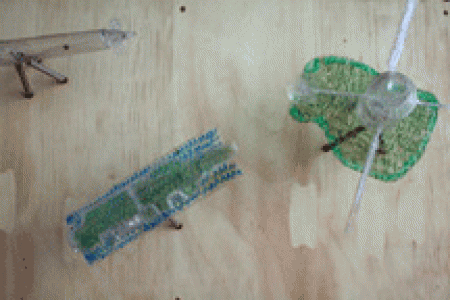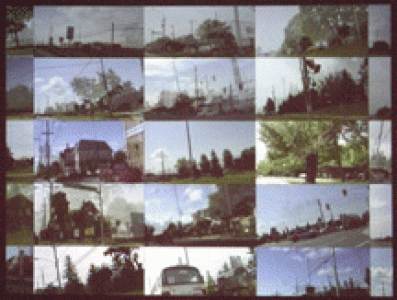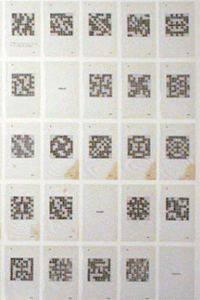Past Exhibition
TEST SITE
Troy Ouellette
Cheryl Rondeau
Zev Farber
Jaime Angelopoulos
Eshrat Erfanian
Elle Flanders
Lauren Goldman
Risa Horowitz
Anthony Koutras
Catherine Lane
Julieta Maria
Dustin Wenzel
January 2010
Nuclear weapons tests are carried out to determine effectiveness, yield, and explosive capability. Throughout the twentieth century most nations that developed nuclear weapons experimented with their potential and strength. These tests are conducted on barren terrain or underwater. The experiments generate vital information about how the weapons work and behave under varying conditions, as well as how surrounding structures ‘react’ to the explosions. Nuclear tests are also overtly political, being used to demonstrate both scientific mastery and military strength.
The Fine Art graduate and doctoral students in Visual Arts & Culture at York University are conducting their own experiments for Test Site, an exhibition at the Durham Art Gallery, investigating the impact of their work on new audiences. In preparation for their upcoming theses defenses, the graduating students will be able to study the effects of their work though engagement and critical feedback. As a site for new ideas, projects, and exchanges, the gallery’s grounds are being used to review the potential of ideas and the strength of mediums, gauging the force of the work at this critical juncture in their education. Most are works in progress, pliable and open for interpretation, making visible layers of information and results of labour.
Anthony Koutras’ mock-ups are one example of this visibility. Koutras allows us behind the scenes as the trickery of his photographic practice becomes transparent. Manipulating scale, he unveils the models used to create his carefully constructed photographs. Documenting banal urban objects (garbage cans, mailboxes, pylons, etc.), he builds three-dimensional models, photographs the minute replications, and then greatly enlarges these images creating a visible lineage of reproduction. Troy Ouellette also controls scale with his maquettes of satellites. Built from recycled plastic bottles, the translucent structures hover in space surrounded by schematic drawings of the fnal productions. While Ouellette diminishes the size of his hypothetical models, sculptor Jaime Angelopoulos blows hers up with large-scale works on paper that act as plans for dimensional designs.
Examining a new direction, Lauren Goldman’s abstract work is still in development and brings together the studio and the white cube. The work is a replication of one of her studio walls that has been transported from York University to the gallery in Durham. The wall presents a series of figurative paintings. The haunting video of Dustin Wenzel shows another work-in-progress: A rotating three-dimensional graphic constructed from schematic diagrams of organic forms which have been doubled, shifted, or otherwise altered. An adaptation of Zev Farber’s is also proposed, with a selection from a much larger, ongoing fictitious narrative investigation. Julieta Maria’s videos are decidedly more abstract, documenting performances of destruction, reconstitution and the carefully positioned works of Catherine Lane that weave into the administrative fabric of the Durham Art Gallery’s office and visitor information section, creating a comic book effect in clerical surroundings.
Cheryl Rondeau’s chronicles come by way of quick video flashes from the bike lane. Her expeditions transport the viewer from point A to point B via video recorded from the perspective of the handlebars of her bicycle. The monotony of repetition is played out through the interweaving and multiplication of both time-lapse photography and video taken over the course of a few weeks. 43˚38’23”N 79˚25’55”W <--> 44˚00’33”N 79˚33’50”W is a mesmerizing view of one commuter’s journey. Eshrat Erfanian produced a new video installation specifically for this exhibition. Two seemingly homogenous landscapes shift into one another, making it difficult to discern the origin of either. These landscapes are, however, very different geographically, politically, and socially. One world (Tehran, Iran) is a major city in a country fraught with conflict while the other (Durham, Ontario) is a small rural community with a quiet simplicity. Shown in tandem, the two scenes resolve to become one with the innocence of a child’s winter play.
Testing presentation strategies of video installation, Elle Flanders will stage a one-night screening of a series of short films. Road Movie is a preview of a twelve-screen installation developed for the Toronto Palestine Film Festival. Each film takes us on a small journey on what have become known as the ‘Apartheid Roads’ in contemporary Palestine. In another event, Risa Horowitz builds an arsenal for future works of word play by hosting a friendly challenge to the local residents in a Scrabble throw-down. The word game has become a hobby informing her practice through research and accumulation, creating pairings and points that are recognized in the secret world of competitive Scrabble. All of the artists in this project are responding to new interests, breaking ground for new ideas, and allowing the reverberations to change the shape of their practice. Test Site addresses the explosive potential in the presentation of their work and hope to measure the seismic effects of interaction and dialogue.
The Durham Art Gallery has a history of supporting visual art graduate programs, bringing in students from the Ontario College of Art & Design, Guelph University, the University of Western Ontario, the University of Waterloo, Georgian College in Barrie and UofT at Sheridan. Like the Nevada Nuclear Test Site, now a tourist attraction garnering hundreds of observers to see the mushroom clouds, the gallery has lured an audience to view the work of recent graduates. We thank them for their continued support and recognition.
— Suzanne Carte-Blanchenot



